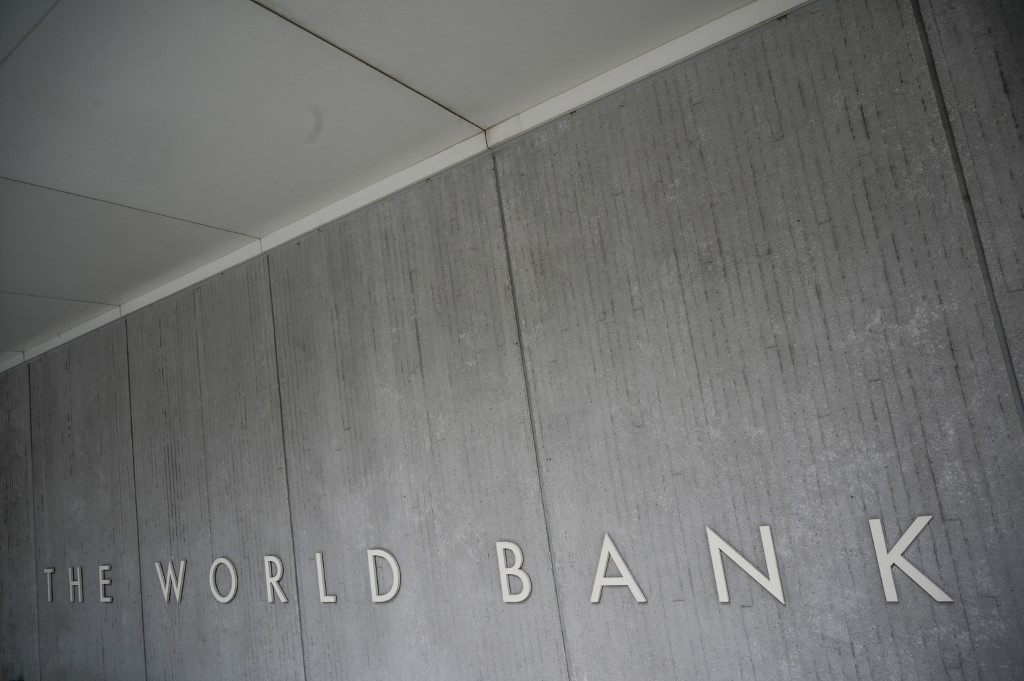
The World Bank Group logo is seen on the building of the Washington-based global development lender in Washington on January 17, 2019. (FILE photo by Eric BARADAT / AFP)
MANILA, Philippines — School children in the Philippines struggled with remote learning, aggravating learning poverty in the country to a new high of 90 percent amid the prolonged COVID-19 pandemic, a new World Bank report showed.
Citing preliminary evidence, the World Bank said in a Nov. 18 statement that its report titled “Remote Learning During COVID-19: Lessons for Today” found out that “while remote learning has not been equally effective everywhere, hybrid learning is here to stay.”
“Going forward, for remote learning to deliver on its potential, the analysis shows the need to ensure strong alignment between three complementary components: effective teaching, suitable technology, and engaged learners,” the World Bank said.
Due to one of the most stringent and longest lockdowns in the region, the Philippines stopped in-person schooling and relied on online classes or its hybrid wherein students answered “modules” or watched television or listened to the radio for lessons.
Only this week did the Department of Education (DepEd) pilot face-to-face classes in select schools located in areas with the lowest risks of COVID-19 transmission.
The World Bank said that in March 2021, remote learning in the Philippines covered only 20 percent of households with school children — the lowest rate alongside Ethiopia.
This jacked up learning poverty — the share of 10-year-olds who cannot read nor understand a simple story — in the country, which was estimated to have risen to as much as 90 percent as of August, World Bank calculations showed.
In 2019 or before COVID-19 struck, learning poverty in the Philippines was already a high of 69.5 percent.
Also, the World Bank said that “children’s engagement with remote learning is generally low where parents or caregivers lack any type of education and, in several countries, these children were three-to-four times less likely to engage in a learning activity compared to households where parents have tertiary education, as seen in the Philippines and Peru.”
World Bank surveys conducted in March showed that in the Philippines, only 9 percent of school children with elder household members who had no education participated in remote learning activities.
In contrast, 40 percent of school kids with parents or guardians who had tertiary or college-level education engaged in remote learning.
For households with adults who reached primary or secondary education, the participation rates were both 16 percent.
Lack of access to the internet and slow connection also hindered remote learning.
World Bank estimates showed that only 26.9 percent of students in the Philippines have broadband internet access, although a bigger 88.8 percent have access to mobile technology.
Broadcast media also have a relatively wide reach as TV reaches 76.9 percent of learners, while a lower 51.2 percent have radio access.
“Hybrid learning — which combines in-person and remote learning –- is here to stay. The challenge will be the art of combining technology and the human factor to make hybrid learning a tool to expand access to quality education for all,” World Bank global director for education Jaime Saavedra said.
“Information technology is only a complement, not a substitute, for the conventional teaching process — particularly among pre-school and elementary school students. The importance of teachers, and the recognition of education as essentially a human interaction endeavor, is now even clearer,” Saavedra added.
Socioeconomic Planning Secretary Karl Kendrick Chua had said that the past school year when students were unable to attend classes in-person was estimated to result in P11-trillion worth of productivity losses during a 40-year period covering a person’s usual working life span.
Earlier estimates of the Manila-based Asian Development Bank (ADB) showed that the economy likely incurred P1.9 trillion in losses for each year that schools were closed.
Besides the Philippines, other countries whose schools were fully closed as of October included the Bahamas, Barbados, Belize, Brunei Darussalam, Cuba, Dominica, Fiji, Grenada, Jamaica, Myanmar, Sri Lanka, Sao Tome and Principe, and Uganda, the World Bank said.

